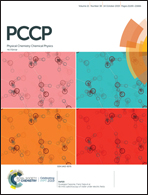2Ch–2N square and hexagon interactions: a combined crystallographic data analysis and computational study†
Abstract
In recent years, chalcogen bonding (ChB), a typical σ-hole interaction, has shown great potential as a bottom-up design approach for specific applications. According to our survey of the Cambridge Structural Database (CSD), a large number of crystal structures containing 2Ch–2N square and hexagon interaction motifs were extracted. On the basis of the CSD search results, the 2Ch–2N square interactions in the dimers of 2,1,3-benzochalcogenadiazole 1 and 2,1,3-pyridochalcogenadiazole 2, together with 2Ch–2N hexagon interactions in the dimers of chalcogenazolo-pyridine 3 and triazolo-chalcogenadiazole 4, were firstly studied. Then, substituent effects on these peculiar interactions were thoroughly examined by introducing a diversity of small, non-aromatic substituents at the 4,7-positions of the 1S scaffold and various aryl substituents at the 2-position of the 3Te scaffold. Our calculations showed that the major contribution to the attraction of such bidentate ChB interactions is electrostatics, while the orbital term also plays an important role. Some strong electron-withdrawing substituents, such as NO2, CN, and CF3, tend to enhance square ChB interactions, while C6F5 and CF3 substituents with a strong electron-withdrawing ability strengthen hexagon ChB interactions. Particularly, a good linear correlation has been established between the binding energies of the dimers under study and both the surface electrostatic potential (ESP) maxima for the Ch σ-holes and the minimum surface ESP of the N atoms, which provides reasonable models to evaluate these interactions. The results reported in this work will provide design guidance for the applications of 2Ch–2N cyclic motifs in materials science and biochemistry.



 Please wait while we load your content...
Please wait while we load your content...